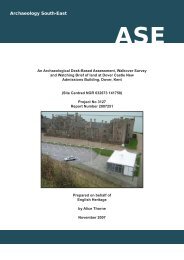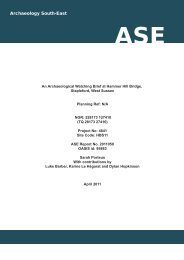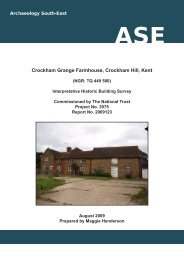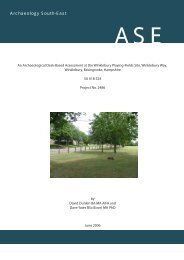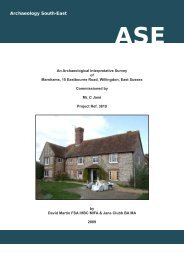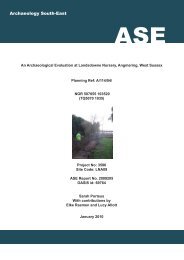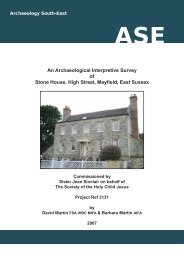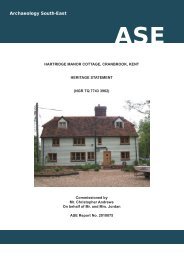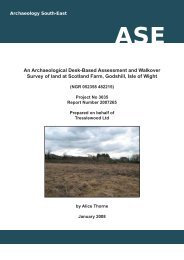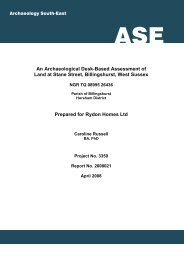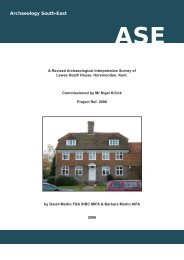ASE front cover - Archaeology South-East
ASE front cover - Archaeology South-East
ASE front cover - Archaeology South-East
Create successful ePaper yourself
Turn your PDF publications into a flip-book with our unique Google optimized e-Paper software.
<strong>Archaeology</strong> <strong>South</strong>-<strong>East</strong>2008058: Holbury Infants School, Holbury, Hampshirecharcoal and metal waste were noted at various points around the site (SMRReference SU40SW 74; Figure 1, Point 2). A number of hearths wereobserved in association with the remains of wattle and daub and Romanpottery but no further details are available about their construction (SMRReference SU40SW 48C; Figure 1, Point 7).2.11 Iron Age pottery was re<strong>cover</strong>ed during an excavation to the southwest of thesite (SMR Reference SU40SW 72A; Figure 1, Point 8) along with Romanpottery (SMR Reference SU40SW 72B; Figure 1, Point 9) including sherdspossibly dating to the 4 th century AD (SMR Reference SU40SW 73; Figure 1,Point 10) and two coins of probable 4 th century AD date (SMR ReferenceSU40SW 72C; Figure 1, Point 11).2.12 Prehistoric activity is known in the vicinity of the site from a number of EarlyBronze Age barrows recorded at Holbury Purlieu, to the northwest of the site,comprising of a round barrow recorded as an undisturbed tumulus in the1930’s, in an area subject to extensive gravel working. A further three bowlbarrows have been noted, two of which were recorded in 1954 (and laterconfirmed in 1969), all three of which have been damaged by modern activitysuch as the construction of cattle tracks. A twin barrow has also beenobserved at Holbury Purlieu comprising of two overlapping Early Bronze AgeBowl Barrows, this too has been damaged by modern activity and animalburrowing. A Neolithic leaf shaped arrow head was re<strong>cover</strong>ed to thesoutheast of the site from the surface of a field after ploughing in 1969 (SMRReference SU40SW 14; Figure 1, Point 12). Mesolithic and Neolithic flinttools, including a Mesolithic tranchet axe, sharpening flakes, two cores andtwenty nine unretouched blades and flakes along with other worked piecesand a quantity of Neolithic worked flint were re<strong>cover</strong>ed during excavations atHolbury Manor from the area between the moated site and the manor house.2.13 In the wider vicinity of the site, across Hampshire there were a number of keysites during the Roman period. A small town developed at Bitterne adjacentto the River Itchen and slightly further a field Venta Belgarum (Winchester)was an important Roman city. A number of rural industries developed inHampshire, namely that of coarse pottery and the manufacture of bricks andtiles. Pottery kilns are known throughout the county, particularly to the eastand west and brick and tile manufacture is known throughout the region(Johnston 1981, 51). The New Forest industry, where there were three majorpottery kiln sites, has been well studied since the early 20th century (Fulford1996, 32). Hampshire based Roman kiln sites are of major significance tostudies of the industry and those at the New Forest and Alice Holt are ofregional and national importance, with products from the New Forestreaching as far as Wales (Fulford 1996, 33). There have been twoapproaches to studies: the kiln structures themselves and the distribution ofthe pottery wares. It is important to consider the wider landscape setting andassociated settlements (Fulford 1996, 33) this in turn facilitating a betterunderstanding of Roman occupation and evidence such as that recordedduring the watching brief.4© <strong>Archaeology</strong> <strong>South</strong>-<strong>East</strong>



